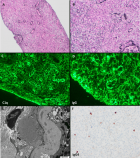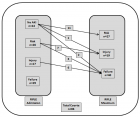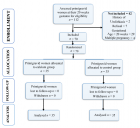Abstract
Mini Review
Angiotensin II type 1 receptor and the activation of Myosin Light-Chain Kinase and Protein Kinase C-βII: Mini Review
Gerry A Smith*
Published: 17 February, 2020 | Volume 5 - Issue 1 | Pages: 024-028
The involvement of the angiotensin II type 1 receptor in the Frank-Starling Law of the Heart, where the various activations are very limited, allows simple analysis of the kinase systems involved and thence extrapolation of the mechanism to that of angiotensin control of activation of cardiac and skeletal muscle contraction. The involvement of phosphorylation of the myosin light chain in the control of contraction is accepted but not fully understood. The involvement of troponin-I phosphorylation is also indicated but of unknown mechanism. There is no known signal for activation of myosin light chain kinase or Protein Kinase C-βII other than Ca2+/calmodulin but the former is constitutively active and thus has to be under control of a regulated inhibitor, the latter kinase may also be the same. Ca2+/calmodulin is not activated in Frank-Starling, i.e. there are no diastolic or systolic [Ca2+] changes. I suggest here that the regulated inhibition is by myosin light chain phosphatase and/or β-arrestin. Angiotensin activation, not involving G proteins. is by translocation of the β-arrestin from the sarcoplasm to the plasma membrane thus reducing its kinase inhibition action in the sarcoplasm. This reduced inhibition has been wrongly attributed to a mythical downstream agonist property of β-arrestin.
Read Full Article HTML DOI: 10.29328/journal.jccm.1001081 Cite this Article Read Full Article PDF
Keywords:
Frank-Starling; angiotensin receptor; muscle contraction; myosin light chain kinase; Protein Kinase C-βII; myosin light chain phosphatase; β-arrestin; myosin bound MgATP ⇌ MgADP-phosphomyosin equilibrium; myosin LC affinity for Ca2+ FullText PDF
References
- van der Velden J, de Jong JW, Owen VJ, Burton PB, Stienen GJ, Effect of protein kinase A on calcium sensitivity of force and its sarcomere length dependence in human cardiomyocytes. Cardiovasc Res. 2000; 46: 487–495. PubMed: https://www.ncbi.nlm.nih.gov/pubmed/10912459
- Steinberg SF. Cardiac actions of protein kinase C isoforms. Physiology. 2012; 27: 130–139. PubMed: https://www.ncbi.nlm.nih.gov/pubmed/22689788
- Chandra M, Dong WJ, Pan BS, Cheung HC, Solaro RJ. Effects of Protein Kinase A Phosphorylation on Signaling between CardiacTroponin I and the N-Terminal Domain of Cardiac Troponin C. Biochemistry; 1997; 36: 13305-13311. PubMed: https://www.ncbi.nlm.nih.gov/pubmed/9341222
- Kobayashi T, Dong WJ, Burkart EM, Cheung HC, Solaro RJ. Effects of Protein Kinase C Dependent Phosphorylation and a Familial Hypertrophic Cardiomyopathy-Related Mutation of Cardiac Troponin I on Structural Transition of Troponin C and Myofilament Activation. Biochemistry. 2004; 43: 5996-6004. PubMed: https://www.ncbi.nlm.nih.gov/pubmed/15147183
- Smith GA. The Mechanisms of the Frank-Starling Law and Familial Cardiomyopathy are Different. The Function of Myosin Binding Protein-C is Retained on Myocyte Length Increase and Force Generated is Kinase controlled. OAT J Integr Cardiol. 2019; 5.
- Smith GA. Calcium, Actomyosin Kinetics, Myosin Binding Protein-C and Hypertrophic Cardiomyopathy. OAT J Integr Cardiol. 2019; 5.
- Solaro RJ, Shiner JS. Modulation of Ca2+ control of dog and rabbit cardiac myofibrils by Mg2+. Comparison with rabbit skeletal myofibrils. Circ Res. 1972; 39: 8–14. PubMed: https://www.ncbi.nlm.nih.gov/pubmed/132310
- Lionne C1, Brune M, Webb MR, Travers F, Barman T. Time resolved measurements show that phosphate release is the rate limiting step on myofibrillar ATPases. FEBS Letters. 1995; 364: 59-62. PubMed: https://www.ncbi.nlm.nih.gov/pubmed/7750544
- Lymn RW, Taylor EW. Transient state phosphate production in the hydrolysis of nucleoside triphosphates by myosin. Biochemistry. 1970; 9: 2975–2983. PubMed: https://www.ncbi.nlm.nih.gov/pubmed/4248809
- Pan BS, Solaro RJ. Calcium-binding properties of troponin-C in detergent skinned heart muscle fibers. J Biol Chem. 1987; 262: 7839-7849. PubMed: https://www.ncbi.nlm.nih.gov/pubmed/3584144
- Morimoto S, Ohtsuki I. Ca2+ binding to cardiac troponin-C in the myofilament lattice and its relation to myofibrillar ATPase activity. Eur J Biochem. 1994; 226: 597-602. PubMed: https://www.ncbi.nlm.nih.gov/pubmed/8001574
- Kampourakis T, Yan Z, Gautel M, Sun YB, Irving M. Myosin binding protein-C activates thin filaments and inhibits thick filaments in heart muscle cells. Proc Natl Acad Sci U S A. 2014; 111: 18763–18768. PubMed: https://www.ncbi.nlm.nih.gov/pubmed/25512492
- Hofmann PA, Hartzell HC, Moss RL. Alterations in Ca2+ sensitive tension due to partial extraction of C-protein from rat skinned cardiac myocytes and rabbit skeletal muscle fibers. J Gen Physiol. 1991; 97: 1141–1463. PubMed: https://www.ncbi.nlm.nih.gov/pubmed/1678777
- Zhang X, Kampourakis T, Yan Z, Sevrieva I, Irving M. et al. Distinct contributions of the thin and thick filaments to length-dependent activation in heart muscle. eLife. 2017; 6: e24081. PubMed: https://www.ncbi.nlm.nih.gov/pubmed/28229860
- de Tombe PP, Mateja RD, Tachampa K, Ait Mou Y, Farman GP, et al. Myofilament length dependent activation. J Mol Cell Cardiol. 2010; 48: 851–858. PubMed: https://www.ncbi.nlm.nih.gov/pubmed/20053351
- Akella AB, Su H, Sonnenblick EH, Rao VG, Gulati J. The Cardiac Troponin C Isoform and the Length Dependence of Ca2+ Sensitivity of Tension in Myocardium. J Mol Cell Cardiol. 1997; 29: 381–389. PubMed: https://www.ncbi.nlm.nih.gov/pubmed/9040052
- Tachampa K, Wang H, Farman GP, de Tombe PP. Cardiac Troponin I Threonine 144. Role in Myofilament Length–Dependent Activation. Circ Res. 2007; 101: 1081-1083. PubMed: https://www.ncbi.nlm.nih.gov/pubmed/17975107
- Wang H, Grant JE, Doede CM, Sadayappan S, Robbins J, et al. PKC-βII sensitizes cardiac myofilaments to Ca2+ by phosphorylating troponin I on threonine-144. J Mol Cell Cardiol. 2006; 41: 823-833. PubMed: https://www.ncbi.nlm.nih.gov/pubmed/17010989
- Blobe GC, Stribling DS, Fabbro D, Stabel S, Hannun YA. Protein Kinase C-βII specifically binds to and is activated by F-actin. J Biol Chem. 1996; 271: 26: 15823–15830. PubMed: https://www.ncbi.nlm.nih.gov/pubmed/8663149
- Abraham DM, Davis RT, Warren CM, Mao L, Wolska BM. et al. β-Arrestin mediates the Frank–Starling mechanism of cardiac contractility. Proc Natl Acad Sci U S A. 2016; 113: 50: 14426–14431. PubMed: https://www.ncbi.nlm.nih.gov/pubmed/27911784
- Ponnam S, Sevrieva I, Sun YB, Irving M, Kampourakis T. Site-specific phosphorylation of myosin binding protein-C coordinates thin and thick filament activation in cardiac muscle. PNAS. 2019; 116: 15485-15494.
- Ribas C, Penela P, Murga C, Salcedo A, García-Hoz C, et al. The G protein-coupled receptor kinase (GRK) interactome: Role of GRKs in GPCR regulation and signaling. Biochimica et Biophysica Acta (BBA) – Biomembranes. 2007; 1768: 913-922.
- Gurevich VV, Gurevich EV. GPCR Signaling Regulation: The Role of GRKs and Arrestins. Frontiers in Pharmacology. 2019; 10: 125. PubMed: https://www.ncbi.nlm.nih.gov/pmc/articles/PMC6389790/
- Wolf H, Hofmann F. Purification of myosin light chain kinase from bovine cardiac muscle. Proc Natl Acad Sci U S A. 1980; 77: 5852-5855. PubMed: https://www.ncbi.nlm.nih.gov/pubmed/6934518
- Walsh MP, Vallet B, Autric F, Demaille JG. Purification and Characterization of Bovine Cardiac Calmodulin dependent Myosin Light Chain Kinase. J Biol Chem. 1979; 254: 12136-12144. PubMed: https://www.ncbi.nlm.nih.gov/pubmed/500701
- Wilden U, Hall SW, Kühn H. Phosphodiesterase activation by photoexcited rhodopsin is quenched when rhodopsin is phosphorylated and binds the intrinsic 48-kDa protein of rod outer segments. Proc Natl Acad Sci U S A. 1986; 83: 1174–1178. PubMed: https://www.ncbi.nlm.nih.gov/pubmed/3006038
- Wilden U, Wüst E, Weyand I, Kühn H. Rapid affinity purification of retinal arrestin (48 kDa protein) via its light-dependent binding to phosphorylated rhodopsin. FEBS Lett. 1986; 207: 292–295. PubMed: https://www.ncbi.nlm.nih.gov/pubmed/3770202
- Turu G, Balla A, Hunyady L. The Role of b-Arrestin Proteins in Organization of Signaling and Regulation of the AT1 Angiotensin Receptor. Front Endocrinol (Lausanne). 2019; 10: 519. PubMed: https://www.ncbi.nlm.nih.gov/pubmed/31447777
- Gagnon L, Yubo Cao Y, Cho A, Sedki D, Huber T, et al. Genetic code expansion and photocross-linking identify different β-arrestin binding modes to the angiotensin II type 1 receptor. J Biol Chem. 2019; 294; 17409-17420.
- Ishikawa Y, Kurotani R. Cardiac Myosin Light Chain Kinase, A New Player in the Regulation of Myosin Light Chain in the Heart. Circ Res. 2008; 102: 516-518. PubMed: https://www.ncbi.nlm.nih.gov/pubmed/18340016
- Stelzer JE, Patel JR, Moss RL. Acceleration of stretch activation in murine myocardium due to phosphorylation of myosin regulatory light chain. J Gen Physiol. 2006; 128: 261–272. PubMed: https://www.ncbi.nlm.nih.gov/pubmed/16908724
- Chang AN, Kamm KE, Stull JT. Role of myosin light chain phosphatase in cardiac physiology and pathophysiology. J Mol Cell Cardiol. 2016; 101: 35–43. PubMed:
- Kumar M, Govindan S, Zhang M, Khairallah RJ, Martin JL, et al. Cardiac myosin-binding protein C and troponin-I phosphorylation independently modulate myofilament length-dependent activation. J Biol Chem. 2015; 290: 29241–29249. PubMed: https://www.ncbi.nlm.nih.gov/pubmed/26453301
- Mamidi R, Gresham KS, Verma S, Stelzer JE. Cardiac Myosin Binding Protein-C Phosphorylation Modulates Myofilament Length-Dependent Activation. Front Physiol. 2016; 7: Article 38. PubMed: https://www.ncbi.nlm.nih.gov/pmc/articles/PMC4753332/
- Sheikh F, Lyon RC, Chen J. Functions of myosin light chain-2 (MYL2) in cardiac muscle and disease. Gene. 2015; 569: 14–20. PubMed: https://www.ncbi.nlm.nih.gov/pubmed/26074085
- Ding P, Huang J, Battiprolu PK, Hill JA, Kamm KE, et al. Cardiac Myosin Light Chain Kinase Is Necessary for Myosin Regulatory Light Chain Phosphorylation and Cardiac Performance in Vivo. J Biol Chem. 2010; 285: 40819-40829. PubMed: https://www.ncbi.nlm.nih.gov/pmc/articles/PMC3003383/
Similar Articles
-
Angiotensin II type 1 receptor and the activation of Myosin Light-Chain Kinase and Protein Kinase C-βII: Mini ReviewGerry A Smith*. Angiotensin II type 1 receptor and the activation of Myosin Light-Chain Kinase and Protein Kinase C-βII: Mini Review. . 2020 doi: 10.29328/journal.jccm.1001081; 5: 024-028
Recently Viewed
-
Exophthalmos Revealing a Spheno Temporo Orbital MeningiomaHassina S*, Krichene MA, Hazil Z, Bekkar B, Hasnaoui I, Robbana L, Bardi S, Akkanour Y, Serghini L, Abdallah EL. Exophthalmos Revealing a Spheno Temporo Orbital Meningioma. Int J Clin Exp Ophthalmol. 2024: doi: 10.29328/journal.ijceo.1001055; 8: 001-003
-
Value of electrocardiographic T wave inversion in lead aVL in prediction of Mid Left Anterior Descending Stenosis in patients with stable Coronary Artery diseaseGehan Magdy*,Awad Yousef. Value of electrocardiographic T wave inversion in lead aVL in prediction of Mid Left Anterior Descending Stenosis in patients with stable Coronary Artery disease. J Cardiol Cardiovasc Med. 2017: doi: 10.29328/journal.jccm.1001015; 2: 056-062
-
Calciphylaxis in HemodialysisLuca Sgarabotto*, Paola Baldini Anastasio, Nicola Marchionna, Monica Zanella. Calciphylaxis in Hemodialysis. J Clini Nephrol. 2023: doi: 10.29328/journal.jcn.1001107; 7: 044-046
-
Metabolic syndrome: A case reportDragan Klaric,Marta Martinis*,Marta Klaric. Metabolic syndrome: A case report. Ann Clin Endocrinol Metabol. 2021: doi: 10.29328/journal.acem.1001022; 5: 031-035
-
Utilization of Molecular Simulation Applications for Stability Testing of Anthocyanin Compounds in Black ElderberryRichard Benedict*. Utilization of Molecular Simulation Applications for Stability Testing of Anthocyanin Compounds in Black Elderberry. Arch Biotechnol Biomed. 2023: doi: 10.29328/journal.abb.1001035; 7: 012-017
Most Viewed
-
Evaluation of Biostimulants Based on Recovered Protein Hydrolysates from Animal By-products as Plant Growth EnhancersH Pérez-Aguilar*, M Lacruz-Asaro, F Arán-Ais. Evaluation of Biostimulants Based on Recovered Protein Hydrolysates from Animal By-products as Plant Growth Enhancers. J Plant Sci Phytopathol. 2023 doi: 10.29328/journal.jpsp.1001104; 7: 042-047
-
Sinonasal Myxoma Extending into the Orbit in a 4-Year Old: A Case PresentationJulian A Purrinos*, Ramzi Younis. Sinonasal Myxoma Extending into the Orbit in a 4-Year Old: A Case Presentation. Arch Case Rep. 2024 doi: 10.29328/journal.acr.1001099; 8: 075-077
-
Feasibility study of magnetic sensing for detecting single-neuron action potentialsDenis Tonini,Kai Wu,Renata Saha,Jian-Ping Wang*. Feasibility study of magnetic sensing for detecting single-neuron action potentials. Ann Biomed Sci Eng. 2022 doi: 10.29328/journal.abse.1001018; 6: 019-029
-
Pediatric Dysgerminoma: Unveiling a Rare Ovarian TumorFaten Limaiem*, Khalil Saffar, Ahmed Halouani. Pediatric Dysgerminoma: Unveiling a Rare Ovarian Tumor. Arch Case Rep. 2024 doi: 10.29328/journal.acr.1001087; 8: 010-013
-
Physical activity can change the physiological and psychological circumstances during COVID-19 pandemic: A narrative reviewKhashayar Maroufi*. Physical activity can change the physiological and psychological circumstances during COVID-19 pandemic: A narrative review. J Sports Med Ther. 2021 doi: 10.29328/journal.jsmt.1001051; 6: 001-007

HSPI: We're glad you're here. Please click "create a new Query" if you are a new visitor to our website and need further information from us.
If you are already a member of our network and need to keep track of any developments regarding a question you have already submitted, click "take me to my Query."

























































































































































